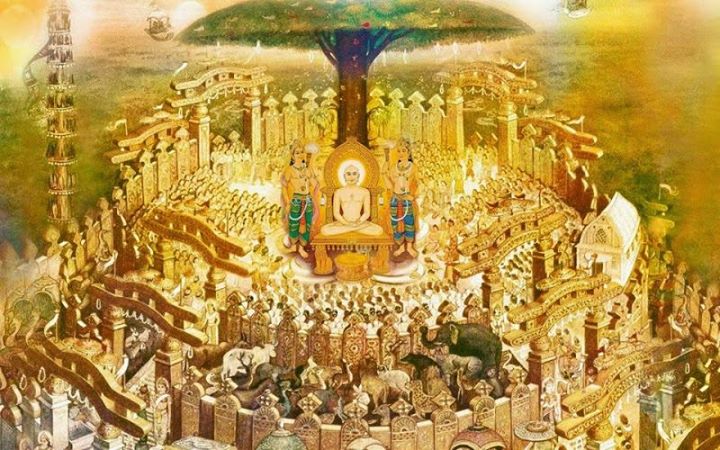Stupa and cavity architecture in the Gupta Period
The literally meaning of Stupa is “Heap“. It is a round mound-shaped Structure used to hold sacred Buddhist relics. Such a lot of stupas were developed in Gupta period.
Apart from the temples, the construction of two Buddhist stupas – Dhemakh Stupa of Sarnath and Jarasangha meeting at Rajgriha is believed to have taken place during the period of Gupta temples. Dhamekh Stupa is 128 feet high, which is constructed on a flat surface without a platform. To keep Buddhist statues at its four corners are made takhs. The laataapatrak on the stupa has been highly acclaimed, and the geometric structures made on it are also notable.
The Mirpur Khas Stupa in Sindh region was built in the early Gupta period. Three small chaityas are made in it. The brick arches have been built in the Central Jatiya. Its engraved and ornate brick and clay Buddha statues are beautiful examples of Gupta pottery art. Narsingh Gupta Baladitya had built a grand temple of Buddha in Nalanda, which was three hundred feet high. Later Chinese travelers praised it.
The temple of Bodhgaya can also be mentioned in the temples of the fifth century. The huge statue of Buddha in its sanctum sanctorum is situated in the ground touch posture. The main entrance is towards the east. Stairs are built near it, which can be reached on the first floor. There is an open space there. The temple has no ventilation or gavach. Thus its plan is unique in itself.
Cavity architecture-
Cavity architecture also developed during the Gupta era. There are two type-Brahmin and Buddhists. some caves of udayagiri near vidisha have been built in this era. These caves here are related to the Bhagwat and Shaiv religions. From udayagiri hill there is an artical by veeresen, the secretary of chandragupta II. Which is known, that he built a shaiv cavity here in honor of Lord Vishnu.
The caves of Udayagiri are not completely engraved and were built by digging and adding stones.
The caves of udayagiri have also been referred to as Mithya Cavity. these cavity have square and plain sanctum sanctorum, with small pavilions on the pillars facing the front. The gateways of the cavity are decorated with statues of river-god and gatekeepers.
Budhhist cavity temple were also built in Gupta period. It may refer to the caves dug in Ajanta and tiger hills. There are a total of 29 caves in Ajanta,there are four chaitygrah and the remaining vihar. They were built from the second century BCE to the seventh century AD. The earliest caves belong to Heenayan and later Mahayaan sects.
Three caves (16th,17th and 19th) are considered to be Gupta period. Among them are sixteenth – seventeenth caves vihar and nineteenth chaity. The sixteenth and seventeenth caves were engraved in the last phase of the fifth century by a minister and a feudal of the Vakataka Naresh Harishan.
The sixteenth cave is the most beautiful of the Ajanta Vihars. Its pavilion has twenty pillars and is built in the shape of 65 sq ft. The sanctum sanctorum is square, in which the gaint statue if buddha is made in Pralambapada Mudra(Hanging legs).The variation of the cavity columns is viewable, as no two are same. The seventeenth cave is also similar in shape to the sixteenth. It was previously called the Rashchakra cave due to the Bhaavachakra (life-cycle) painted on the walls of the porch. Most of the murals are safe in it. The nineteenth cave is a chaity, in which the sanctum sanctorum, corridor and pillar are built like the previous chaityas. In this, wood has not been used to decorate the main part. The flat roof of the entrance rests on four pillars, and at the top is a large shaped chaitya window.
The stylized Stupa has a high cylindrical egg, On top of which are round dome, Harmika and three parasol. There are also figures of Yaksha, Nagadampati, Shalabhanjika, Rishi Munis etc. the chaitygrah has only one entrance. There are 27 lined columns on the pradakshinamarg a on both side of the pavilion.This cave has been made in the sculptures of the best chaityagrhas of Western India, which are engraved in human form on the entrance gate, the ankles and the monolithic stupa. It seems that Mahayana was influenced by them.
Tiger caves-
Like Ajanta, nine caves are obtained from Tiger hill( located in Dhaar district of Madhya Pradesh). Whose time is different-different. Some of them are Gupta.Tiger caves are also related to Buddhism.
All are built for the residence of monks. The first vihara is destroyed. The second is in a safe state, which is called Pandava Cave. It has a square courtyard i middle, which side room have been built. Statue are made on takhon in the porch.The third cave called Elephant Khanaa and fourth cave is called Rangmahal. Painting is found on its walls.The remaining caves have been destroyed.The tiger cave is famous for painting more than its architecture.
Reference : https://www.indiaolddays.com/





